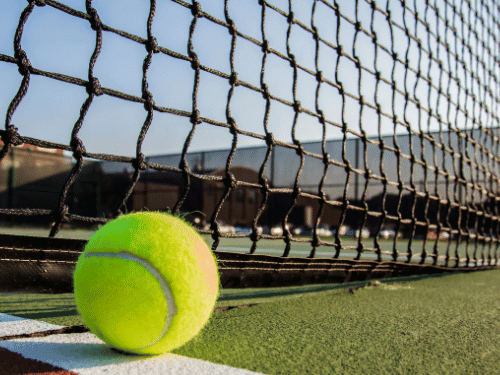Why Are Tennis Balls Pressurized?
Tennis balls are pressurized for a few reasons. The primary reason is to ensure consistent and predictable performance during gameplay, and Pressurization. Pressurization helps maintain the ball’s desired bounce and playability characteristics.
When manufactured, tennis balls are filled with air or a combination of air and nitrogen under high pressure. This pressurized air inside the ball creates internal pressure, which affects its bounce and liveliness on the court. The ball’s rubber core is designed to compress and decompress upon impact, and the pressurized air helps facilitate this process.
Over time, the pressurized air inside the ball gradually escapes through the microscopic pores in the rubber. As a result, the ball loses its internal pressure, and its performance declines. This is why tennis balls become less lively and less responsive after extended use.
Professional tennis tournaments often use newly pressurized balls for each match to maintain the desired characteristics. Regular players also tend to replace tennis balls regularly to ensure consistent performance during games or practice sessions.
It’s worth noting that the International Tennis Federation (ITF) regulates the Pressurization of tennis balls. The ITF sets specific standards for the pressure range that tennis balls should fall within for official tournament play.
The Importance of Tennis Balls in the Game
Tennis balls play a crucial role in the sport, and they directly impact the speed, spin, and bounce of the ball, influencing the overall gameplay experience. With properly pressurized balls, the game would be more dynamic and enjoyable.
Pressurized vs Non-Pressurized Balls
Regarding tennis balls, there are two main categories: pressurized and non-pressurized. Let’s explore the differences between the two.
Performance Differences
Pressurized balls generally offer better performance compared to non-pressurized ones. They provide greater bounce, responsiveness, and playability, making them the preferred choice for competitive and professional players.

Duration of Playability
Non-pressurized or pressureless balls have a Longer lifespan than their pressurized counterparts. While they may offer different performance levels, they are often used for training or recreational play where consistent bounce is not the main focus.
What is Ball Pressure?
It’s important to grasp the concept of ball pressure to understand why tennis balls are pressurized. Tennis balls are made using a combination of rubber and felt, giving them distinct texture and performance characteristics.
Composition of Tennis Balls
Tennis balls consist of a hollow rubber core covered with compressed air. The rubber core provides the ball’s structure and responsiveness, while the felt outer covering offers grip and durability.
Initial Pressure of Tennis Balls
During manufacturing, tennis balls are pressurized to a specific level, typically between 12 to 14 pounds per square inch (psi). This initial pressure ensures consistent performance and bounces when the balls are new.
Pressure Loss over Time
Over time, tennis balls gradually lose their pressure. This loss occurs due to the permeability of the rubber and the escape of compressed air molecules through the ball’s surface. As a result, the ball becomes less responsive, and its performance declines.
The Purpose of Pressurizing Tennis Balls
Pressurizing tennis balls serves several purposes and benefits both players and the game. Let’s explore why maintaining ball pressure is crucial.
Improved Bounce and Performance
Pressurized balls provide a more predictable and consistent bounce. The internal air pressure ensures that the ball rebounds off the ground with a certain level of elasticity, allowing players to anticipate and respond to shots effectively.

Player Preference and Consistency
Maintaining consistent ball pressure across matches is important for players. They become accustomed to the specific characteristics of pressurized balls, such as how they feel on the racket strings and their behavior when struck. Consistency in ball performance enables players to develop and refine their skills over time.
How are Tennis Balls Pressurized?
The Pressurization Pressurization of tennis balls occurs during the manufacturing process. Let’s take a closer look at how it’s done.
Manufacturing Process
Tennis balls are manufactured in specialized facilities using precise machinery. The rubber core is molded, and the felt covering is carefully attached. Before sealing the ball, a specific amount of compressed air is injected, pressuring the ball to the desired level.
Pressurizing Techniques
Manufacturers use various techniques to ensure the desired pressure is achieved. Some employ automated systems that precisely measure and control the pressure, while others rely on manual inspection and adjustment. Regardless of the method, the goal is to maintain consistent pressure across all tennis balls.
Factors Affecting Pressure Loss
While pressurized tennis balls provide optimal gameplay, they inevitably lose pressure over time. Several factors contribute to pressure loss, and it’s essential to understand them.
Temperature and Altitude
Temperature and altitude have a significant impact on pressure loss in tennis balls. Warmer temperatures and higher altitudes accelerate the escape of air molecules from the ball, causing it to lose pressure more quickly. Conversely, colder temperatures and lower altitudes slow down this process.
Ball Storage and Handling
How tennis balls are stored and handled also affects their pressure retention, and exposure to extreme heat or cold can expedite pressure loss. Additionally, rough surfaces, excessive moisture, and improper storage containers can impact the longevity of pressurized balls.
Extending the Life of Pressurized Tennis Balls
If you want to prolong the life of your pressurized tennis balls, there are a few steps you can take.
Proper Storage
Store your tennis balls in a cool, dry place away from direct sunlight and extreme temperatures. A pressurized container can help maintain the ball’s pressure for extended periods.
Reviving Pressurized Balls
If your pressurized tennis balls have lost some bounce, try reviving them. Placing the balls in a clothes dryer on a gentle cycle can help redistribute the internal pressure, restoring some of their original characteristics.
Conclusion
Tennis balls are pressurized to enhance gameplay and provide consistent performance. The internal pressure ensures optimal bounce and responsiveness, allowing players to engage fully in the game. While tennis balls gradually lose pressure over time, proper storage and handling can help extend their lifespan.
Pressurized balls offer superior performance, while non-pressurized balls have a longer playability duration. Regardless of the type, tennis balls remain a vital sport component.
FAQs
1. How often should tennis balls be replaced?
Tennis balls should typically be replaced after every 6 to 8 hours of gameplay or when their pressure significantly decreases, resulting in reduced bounce and performance.
2. Can you reuse pressurized tennis balls?
Pressurized tennis balls can be reused to a certain extent, especially for casual play or practice sessions. However, their performance will diminish over time and eventually need replacement.
3. Do professional tennis players use pressurized balls?
Yes, professional tennis players use pressurized balls in tournaments and matches. Pressurized balls’ consistent performance and bounce allow players to showcase their skills and compete at the highest level.
4. Can you pressurize tennis balls at home?
Pressurizing tennis balls at home is not practical or recommended. The process requires specialized equipment and precision, which can only be achieved in professional manufacturing facilities.
5. What happens if you play with a non-pressurized ball?
Playing with a non-pressurized ball will result in lower bounce and reduced performance, and the ball will feel softer and less responsive, impacting the game’s dynamics.











